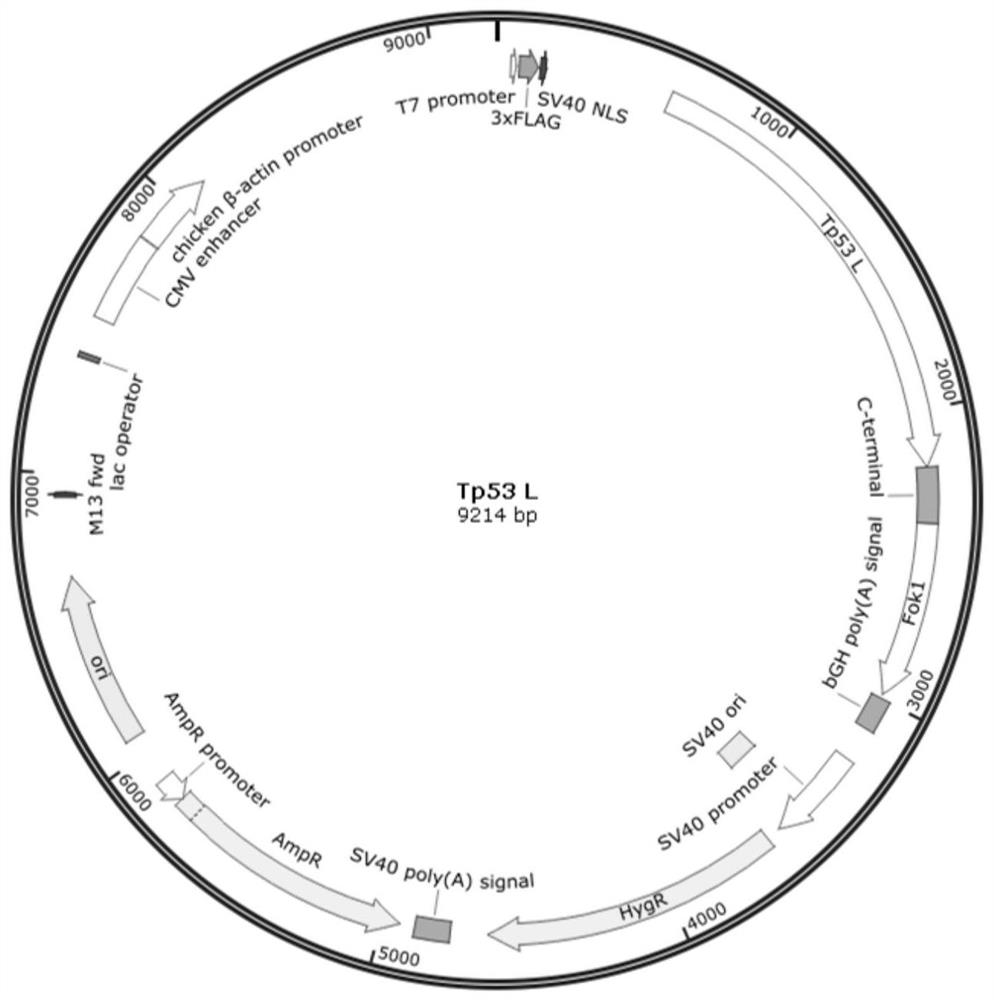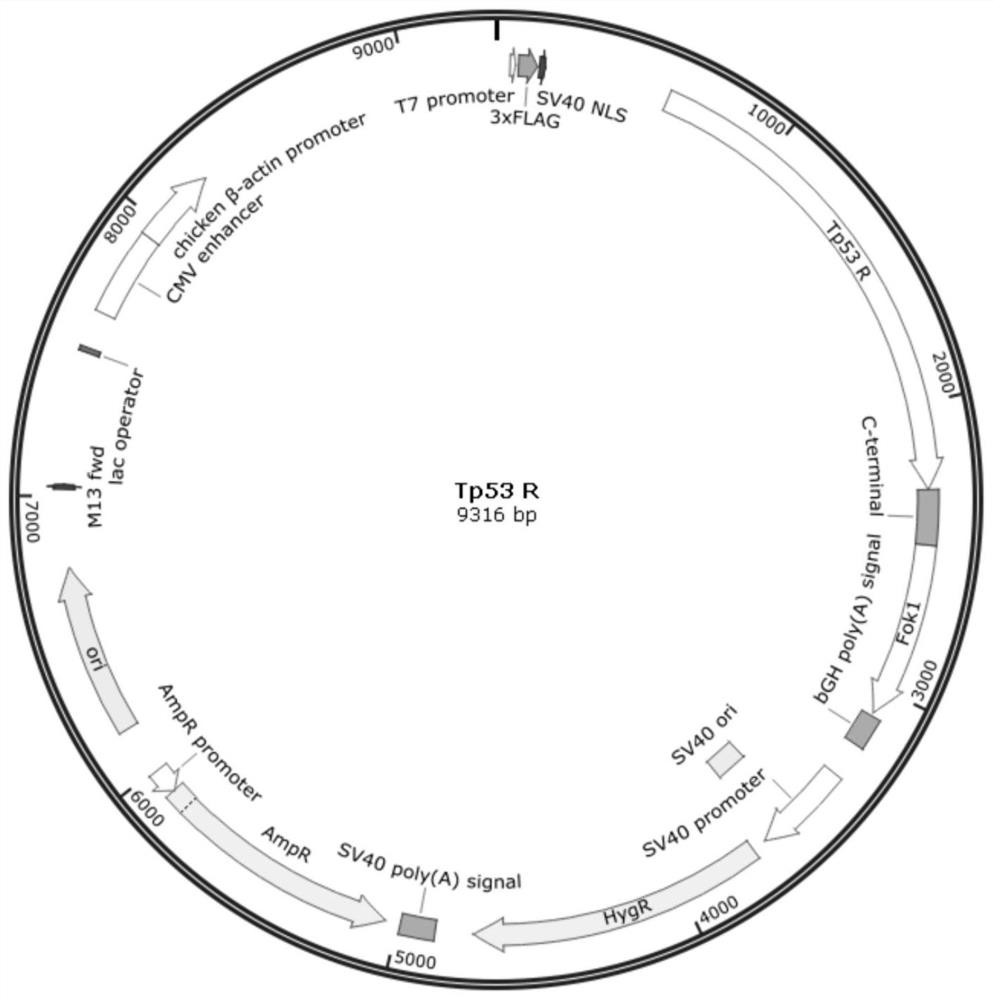Construction method and short peptide of tp53 gene knockout animal model
A construction method and gene technology, applied in the field of constructing Tp53 gene knockout animal models, can solve the problems of impure background, high cost, long production cycle, etc., and achieve the effect of single background, simple preparation and screening process
- Summary
- Abstract
- Description
- Claims
- Application Information
AI Technical Summary
Problems solved by technology
Method used
Image
Examples
Embodiment 1
[0037] Example 1 Design of Tp53 gene-specific TALEN sequence and construction of recognition module
[0038] A pair of short peptides in this embodiment, the short peptides include a first short peptide and a second short peptide; the first short peptide has a sequence structure as shown in SEQ ID NO: 1, and the SEQ ID NO: The sequence structure of 1 is specifically:
[0039] LTPEQVVAIASHDGGKQALETVQRLLPVLCQAHGLTPEQVVAIASHDGGKQALETVQRLLPVLCQAHGLTPEQVVAIASHDGGKQALETVQRLLPVLCQAHGLTPEQVVAIASNGGGKQALETVQRLLPVLCQAHGLTPEQVVAIASHDGGKQALETVQRLLPVLCQAHGLTPEQVVAIASNGGGKQALETVQRLLPVLCQAHGLTPEQVVAIASNNGGKQALETVQRLLPVLCQAHGLTPEQVVAIASNIGGKQALETVQRLLPVLCQAHGLTPEQVVAIASNNGGKQALETVQRLLPVLCQAHGLTPEQVVAIASNGGGKQALETVQRLLPVLCQAHGLTPEQVVAIASHDGGKQALETVQRLLPVLCQAHGLTPEQVVAIASNIGGKQALETVQRLLPVLCQAHGLTPEQVVAIASNNGGKQALETVQRLLPVLCQAHGLTPEQVVAIASNNGGKQALETVQRLLPVLCQAHGLTPEQVVAIASNIGGKQALETVQRLLPVLCQAHGLTPEQVVAIASNIGGRPALE;
[0040] The second short peptide has a sequence structure as shown in SEQ ID NO...
Embodiment 2
[0049] Example 2 Tp53 gene knockout transcriptional activator-like effector
[0050] In order to encode the first short peptide and the second short peptide described in Example 1, a pair of transcriptional activator-like effectors is constructed in this embodiment, and the transcriptional activator-like effectors include the first transcriptional activator-like effector and the first transcriptional activator-like effector The second transcription activator-like effector; the first transcription activator-like effector and the second transcription activator-like effector are respectively transcribed and translated to obtain the first short peptide described in Example 1 and the second short peptide.
[0051] The first transcriptional activator-like effector has a sequence structure as shown in SEQ ID NO: 3, and the sequence structure of SEQ ID NO: 3 is specifically:
[0052]CTGACCCCTGAGCAGGTGGTGGCCATCGCCAGCCACGACGGCGGCAAGCAGGCCCTGGAGACCGTGCAGAGGCTGCTGCCTGTGCTGTGCCAGGCCCACGGC...
Embodiment 3
[0055] Example 3 DNA vector comprising Tp53 gene knockout transcriptional activator-like effector
[0056] The DNA vector of this example contains the transcriptional activator-like effector described in Example 2; as a specific implementation of this example, the DNA vector is a DNA vector that can encode a FokI nucleic acid.
[0057] Specifically, the DNA vector is a DNA plasmid, and the DNA vector includes a first DNA vector and a second DNA vector.
[0058] Such as figure 1 Shown is a schematic diagram of the construction of the first DNA vector, the first DNA vector can recognize the L sequence described in Example 1, and has a sequence structure as shown in SEQ ID NO: 5, the SEQ ID NO: 5 The sequence structure of is specifically:
[0059]
[0060] Such as figure 2 Shown is a schematic diagram of the construction of the second DNA vector, the second DNA vector can recognize the R sequence described in Example 1, and has a sequence structure as shown in SEQ ID NO: 6, th...
PUM
 Login to View More
Login to View More Abstract
Description
Claims
Application Information
 Login to View More
Login to View More - R&D
- Intellectual Property
- Life Sciences
- Materials
- Tech Scout
- Unparalleled Data Quality
- Higher Quality Content
- 60% Fewer Hallucinations
Browse by: Latest US Patents, China's latest patents, Technical Efficacy Thesaurus, Application Domain, Technology Topic, Popular Technical Reports.
© 2025 PatSnap. All rights reserved.Legal|Privacy policy|Modern Slavery Act Transparency Statement|Sitemap|About US| Contact US: help@patsnap.com



